Armored Core 6 isn't Robot Souls, or Elden Mech, and now I'm fine with that
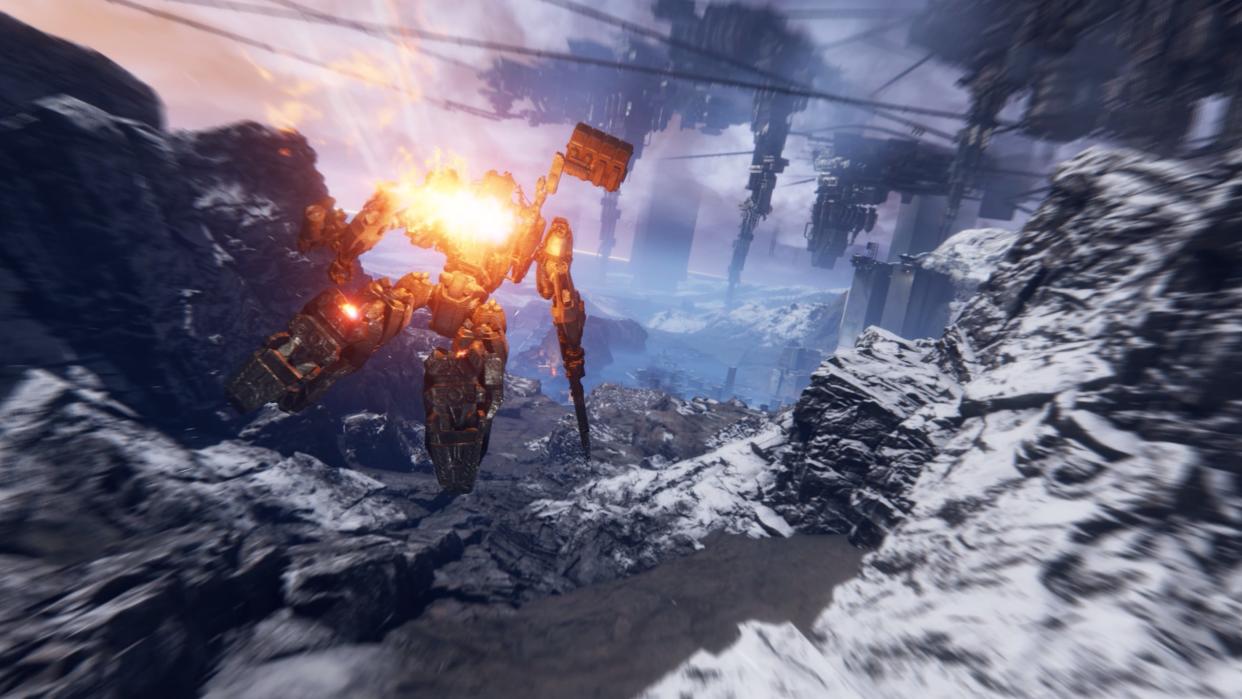
Despite repeated, expectation-managing promises from studio and publisher alike, I went into my Armored Core 6 hands-on with the dumb animal hope that it would be Souls with robots. I don't especially want a Souls-with-robots game; it's more that I will play a Souls-with-X game, made by FromSoftware, as a matter of priority over just about anything else. Armored Core, though? I went in curious, but far from sold.
What I played was a fluid, intense—and most importantly—fast mech combat game that resembled the last and only Armored Core game I ever played, Armored Core 5. Except prettier. And better. And—most importantly—faster. As dim as those memories are, I do remember admiring its determinedly bleak far-future science fiction, while also being upset that it bore no resemblance to the dark fantasy RPG that the same studio released the year before. I dropped it pretty quick.
Armored Core 6 is gorgeously grim: in the areas I saw, endless miniscule neighbourhoods of Soviet-style tower blocks are couched within inhospitable snow-drenched landscapes, surrounded by yards of steely industry, all shadowed by gargantuan skybound tech structures of such byzantine architecture that they resemble something verging on biblical (from the pointy, apocalyptic end). Art direction, in true FromSoftware style, seems hellbent on making you feel tiny, even while you're crushing forests of fir trees on the way to your quarry. This strange scale-dilation is something almost unique to From, and it's the first thing I noticed about Armored Core. You're big compared to the trampled IRL-sized trucks that bounce like tennis balls underfoot, but the structures that loom above you are godlike.
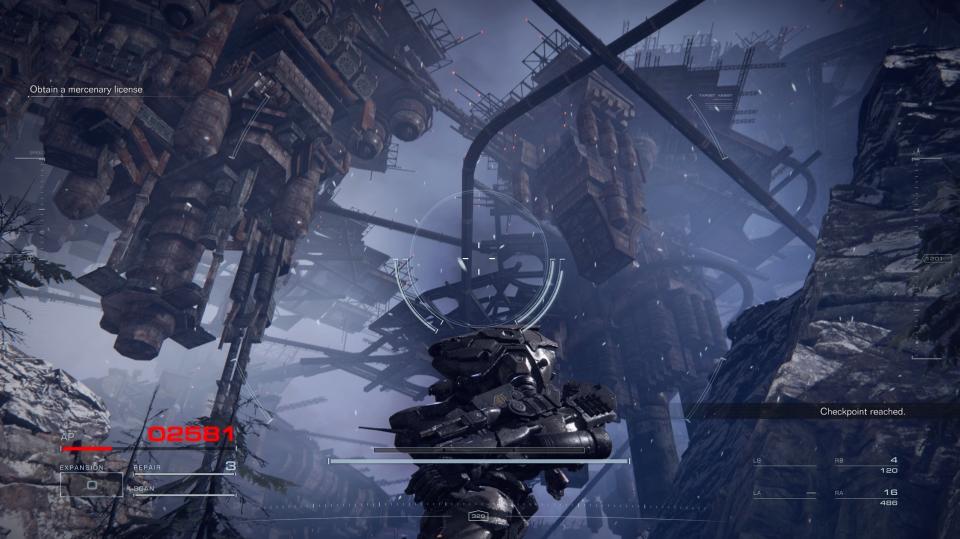
There's a vanquished grandeur to it all, but not much serenity: this is a loud game. Everything is always exploding, and between explosions, blockbuster-style American barks command you to your next target. I'm put in mind, weirdly, of Battlefield.
Heavy metal
I think Armored Core could be a big deal. Not on the scale of Elden Ring, but it's got a lot to offer. It's a skill-oriented robo-action game with a robust customisation element which is really a lot more important—and a lot more fun—than I could ever have hoped. Most importantly, this is a mech game where movement and player technique feels as important as it might in Sekiro, or even a Devil May Cry.
But let's go through the rhythm of the game so you're very clear what you're getting with Armored Core.
Missions are selected from a menu, and take place in large maps. You'll return to these maps for different missions, albeit with different spawn points, in a manner reminiscent of Nioh (or indeed, earlier AC games). In my demo, missions unlocked two at a time. Each starts with a scene-setting briefing, and some can be knocked over in less than five minutes, with simple formats like "destroy these three objectives" or "thug up this one particular target."
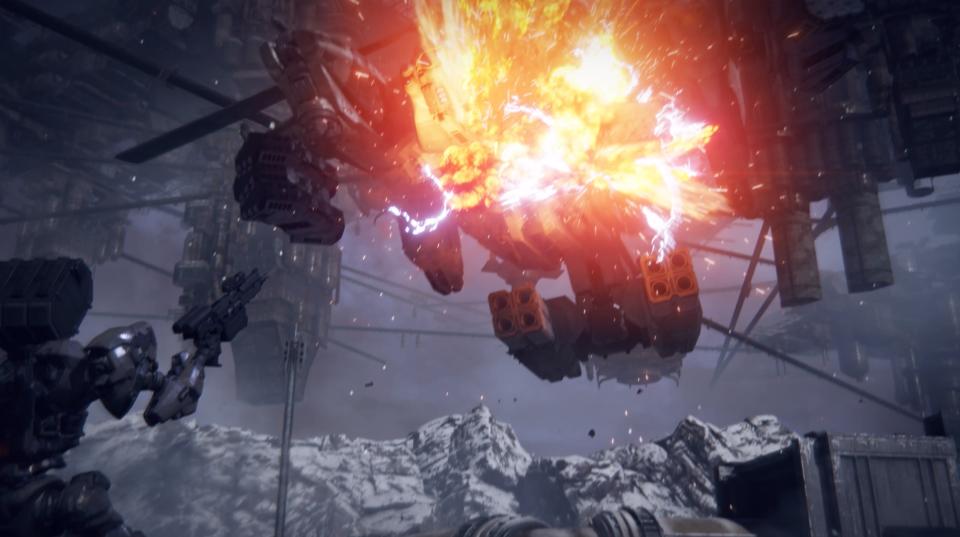
Don't be alarmed, though: they're not all like that. Among these were interspersed some genuinely breathtaking missions that, in the hands of another studio, might just be handled via cutscene. In one, I'm off to a desert wasteland to take down a "Weaponized Mining Ship" called a Strider, which could better be described as an utterly gargantuan dog-shaped robot. Think Elden Ring's Walking Mausoleum. Now think six of 'em stuck together, and six more layered on top: it's bloody massive. Upon approach I must dodge its languorous defence, and then once in range attack some exposed machinery on one of its legs to effectively kneecap it. Its collapse is glacial in its majesty.
If a mission proves too difficult, it's probably because your loadout sucks: back to the menu with you, to find a better build
When the dust settles—literally—I've got to scale this heavenward Strider to bring it down properly, which involves navigating its elaborate exterior without plummeting to my death. Like the Souls games, Armored Core doesn't mind indulging in some high stakes platforming, which can be tricky in a boost-happy slippery mech (as an aside, I absolutely love a game that punishes the player with falls from giddying heights). I hunt down its weak spots, evade incoming ballistics, and finally destroy the giant electrical orb that seems to constitute its heart.
This is a boss battle of brilliant spectacle. Less so is the one in the tutorial: a chunky helicopter. Still, it teaches you an important lesson about Armored Core: your robot may be equipped with a small handful of projectile attacks but you're not a plane, you're a mech, and so you're also going to want to get in close. Using the high speed Assault Boost in conjunction with a melee attack proved much more effective against the chopper than the technique I used the first couple of times, which was to stand back, shoot, and dodge.

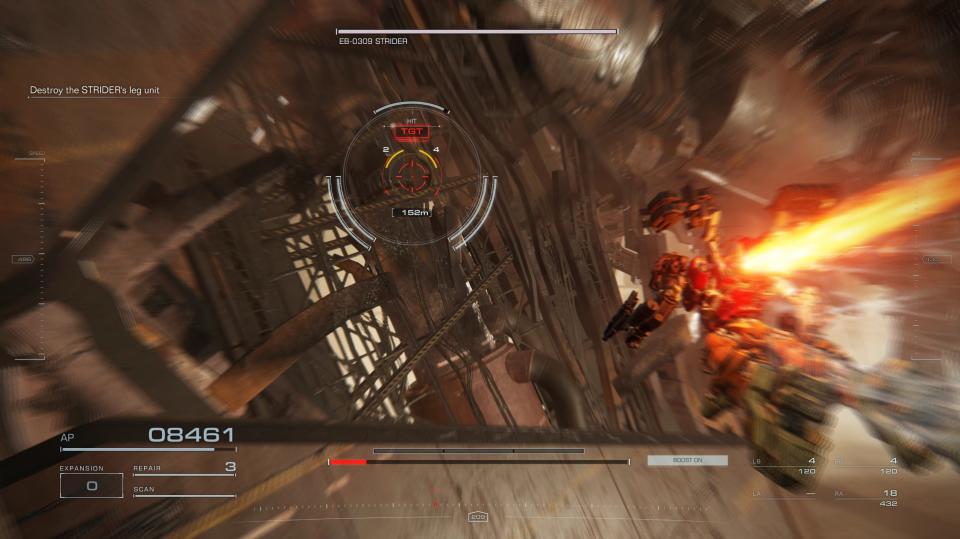
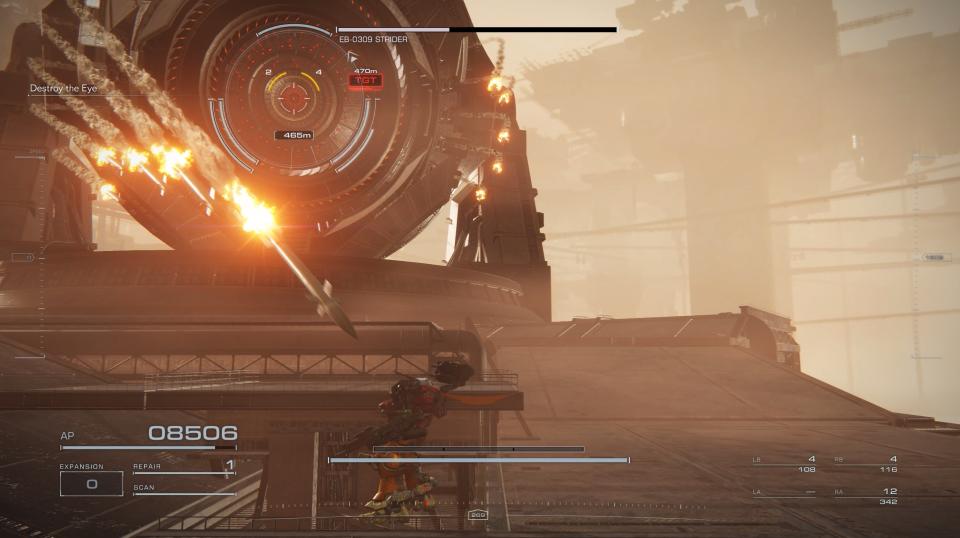
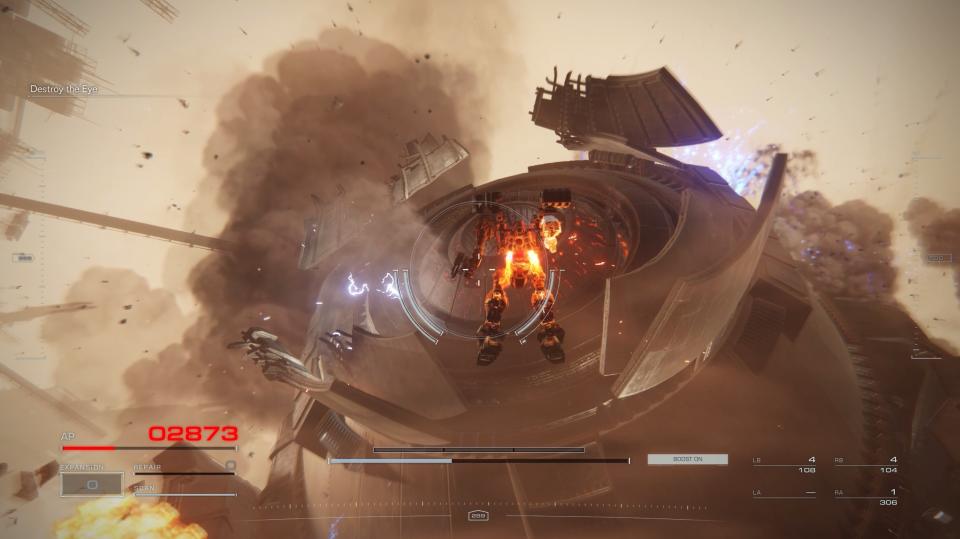
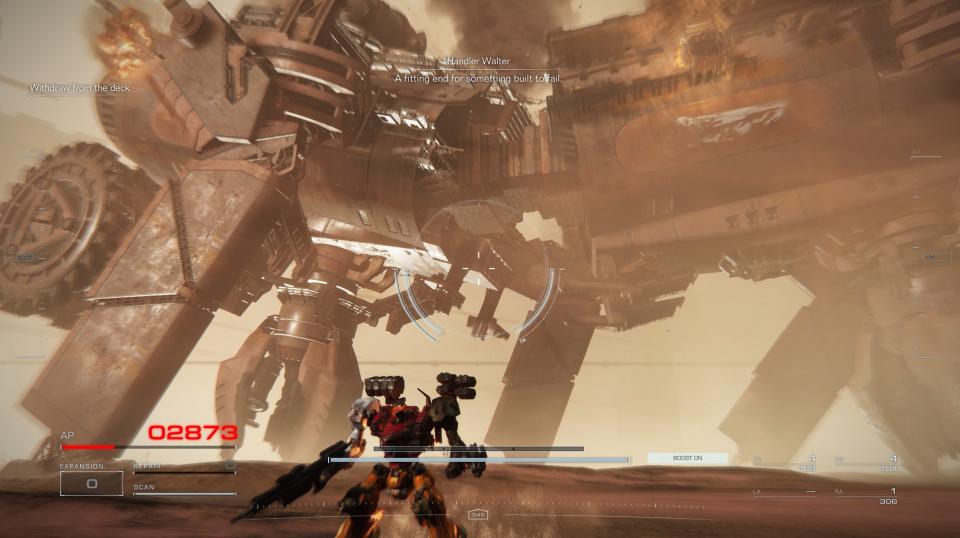
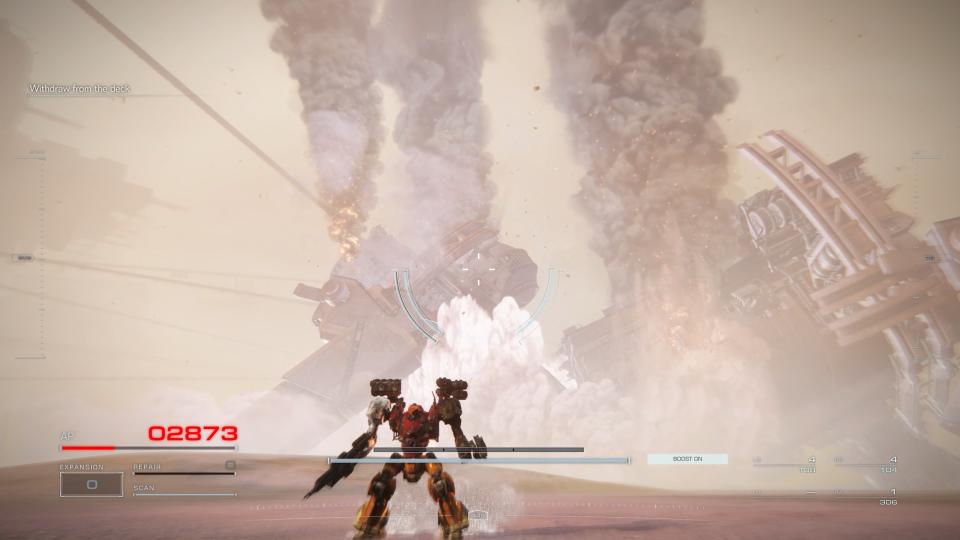
Once a mission is complete, you're thrown back to the menu, where you'll be allowed to spend your hard-earned coin on upgrades for your AC. There's no immersive-but-cumbersome hub area: From Software has drawn the loop as tight as can be. Go out, fuck shit up, then go home and fiddle in some menus to optimise your fuck-upping capacity. If a mission proves too difficult, it's probably because your loadout sucks: back to the menu with you, to find a better build.
Mech bank
Each mission—and each baddie smote per mission—nets you money, which you'll use to buy new parts for your Armored Core. There are 12 discrete components of your AC that can be swapped in and out with specialised gear: both left and right arms and shoulders have weapons, including assault, pulse and plasma rifles, blades and homing missiles. But your arms can be replaced too, your legs, even your head. Coupled with the extensive cosmetic options—endless gradients of colours, hordes of emblems, and even a graphics editor utilising preset shapes that can be layered endlessly—there's a lot of potential for freak flag waving. Each purchased component is yours to keep and swap in and out between missions as you see fit, but you can also sell them.
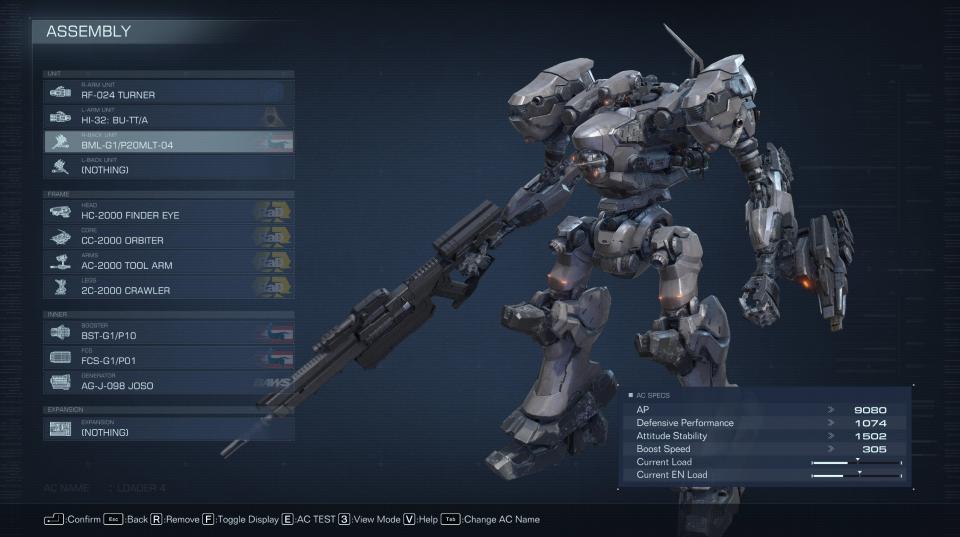
Your AC can charge at delightfully fun speeds using the Assault Boost, and the booster type you use will determine its speed and energy (EN) consumption. The generator you use will determine the charge's length and regen rate, though right out of the gate the regeneration is quick: you're looking at a second. This stamina-bar stand-in is really there to emphasise the distinction between fighter jet and mech. Energy also affects your AC's ability to ascend, glide and dodge. Most decisions I made pertaining to AC loadout—keeping in mind it was very early game and I didn't have a whole lot to mess with—centred around weight. Like the Souls game's equip load stat, exceeding this threshold makes your agile corporate death machine vastly inferior.
Hard core
For the bulk of the three hours I played I felt like this might be a relatively easy game by FromSoftware standards. The blossoming variety caught me unaware: during the eighth mission I played, which begins at the foot of what appears to be an enormous retaining wall, I'm tasked with fighting my way to a door in its centre. I'd blazed through most encounters with liberal soaring and dodging and ballistics spamming, but this time I was getting decimated.
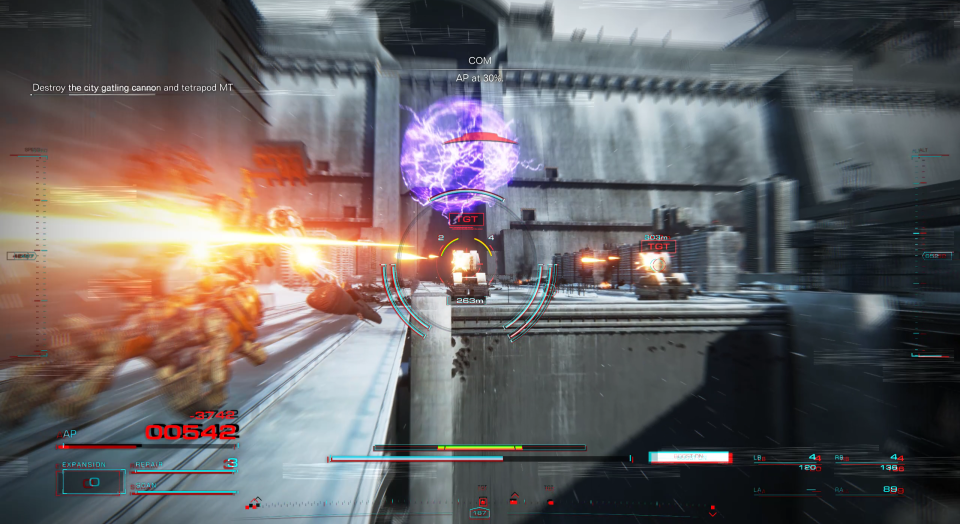
While not quite an infiltration mission—you're a mech, and loud!—this one required me to think carefully about my path to that door, keeping in mind each piece of scant cover, as well as the rockets poised all the way along the wall's crest. Before this moment Armored Core had felt almost easy, but it served to emphasise a crucial element in its design: the mastery of your mech's finer movement capabilities. It put me in mind of Tony Hawk Pro Skater. The ensuing boss drove this point home further. I had to face off against a Juggernaut—a two-phase "boots on the ground" style boss that resembles a kind of cybergoth road grader. The space during this encounter was relatively limited, and verticality didn't really factor into it. I needed to get behind it, regularly, precisely, without skidding too far or falling too short. It was tough: previously I'd been playing this game like Twisted Metal.
I loved my time with Armored Core 6, even though I set out wanting something else. The promise of PvP in concert with the hugely modular approach to mech construction has me excited on behalf of competitive players, too. While I wonder whether some of the shorter, more frivolous missions could wear over the course of a campaign, I always enjoyed commanding my AC, and quickly understood that every buck in my wallet would count. I went in with the futile hope that Armored Core would be Robot Souls. I came out very happy that it's just Armored Core.

